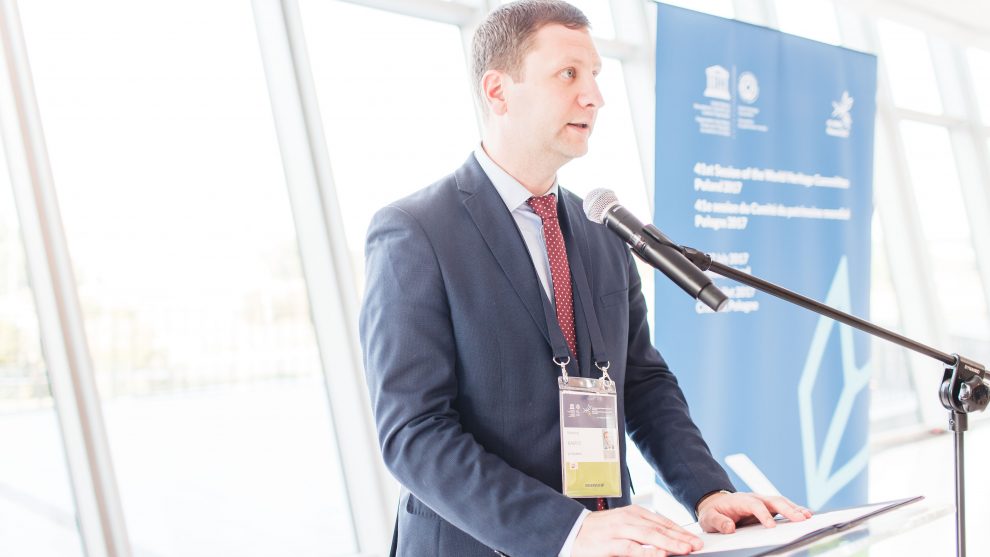Kaunas modernism architecture presented in Krakow

Paskelbta: 2017-07-14 (Friday)
This week, a photograph exhibition ‘Kaunas 1919-1939: The Capital Inspired by the Modern Movement’ created by Gintaras Balčytis and Gintaras Česonis was opened as part of the 41st session of the World Heritage Committee at the ICE Congress Centre in Krakow.
This is an excellent opportunity to introduce the Kaunas modernism architecture to the UNESCO World Heritage specialists, experts and the entire international community, and brief on Lithuania’s commitment to start the procedure for enscribing the Kaunas modernism architecture on the UNESCO World Heritage List.
The City of Kaunas, the Ministry of Culture of the Republic of Lithuania, and the National UNESCO commission have since 2014 been actively seeking to place the Kaunas modernism architecture among the most prominent heritage valuables of the world. Therefore the presentation of the Kaunas architecture, as one of the most prominent examples of early regionalism in the history of modernism architecture at the UNESCO session convened in Krakow is an event of great significance ensuring broader dissemination and publicity of the message about this valuable piece of heritage.
Among the honourable guests of the exhibition ‘Kaunas 1919-1939: The Capital Inspired by the Modern Movement’ opening ceremony were Asta Junevičienė, Secretary General of the Lithuanian National Commission for UNESCO, Šarūnas Adomavičius, the Ambassador of the Republic of Lithuania in the Republic of Poland, the Vice-Mayor of Kaunas Simonas Kairys, and other representative of the Municipality. The opening speech at the exhibition was delivered by prof. Jacek Purchla, the Director of the International Culture Centre in Krakow, the Chair for the World Heritage Committee session for 2017.
The exhibition also attracted the attention of the representatives of the World Heritage Centre. Mechtild Rössler, Director of the Centre, Isabelle Anatole-Gabriel, Chief of the Europe and North America Unit at the World Heritage Centre, the international modernism heritage experts Jad Tabet and Edward Denison, and other experts playing important role in the process of preparation of the nomination of the Kaunas modernism architecture.
Prof. Jacek Purchla stressed that in the world heritage context modernism architecture is still an undiscovered matter, and was delighted to note that by this initiative the city of Kaunas is communicating a message to the world about the rich history of the city, its development, the impact of the different periods, the national identity, the place of heritage in the society, as well as the narrative fabric that Kaunas continues creating today. As an extension to the Professor’s thought the Vice-Mayor Simonas Kairys spoke about the development of Kaunas in the inter-war period, seeking to identify parallels between the temporary capital of the country, and the contemporary Kaunas.
Today the historic landscape of Kaunas is an exceptional example of a modernism and dynamic city that was built anew within just 20 years. During the past three years the Kaunas modernism architecture is undergoing the Renaissance period. In 2015, the European Commission awarded Kaunas with the European Heritage Label, and in the same year the city was included in the UNESCO Creative Cities Network in the field of design; in 2022 Kaunas will be designated the European Capital of Culture, and early in 2017, the modernism architecture was included into the Tentative List of the World Heritage Convention. According to Simonas Kairys, the 41st session of the World Heritage Committee is a most suitable platform to introduce the world heritage community to the modern narrative of Kaunas.
The 41st session of the World Heritage Committee held on July 2-12 in Krakow passes decisions regarding the inscription of new properties in the World Heritage List, discusses the State of Conservation Reports, the properties on the List of World Heritage in Danger, also the properties in danger of extinction or removal from the World Heritage List. The UNESCO World Heritage Committee also considers different strategic, management and operating issues related to the world heritage.
This year total 18 cultural and three natural sites supplemented the World Heritage List, including Asmara, a modernist city of Africa in Eritrea, the old town of Hebron / Al-Khalil in Palestine, the historic city of Ahmadabad in India, landscapes of Dauria in Mongolia, the Russian Federation, etc.
Information of the Public Relations Office





